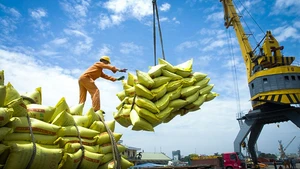A recent report by Vietnam Investors Service And Credit Rating Agency Joint Stock Company (VIS Rating) showed that large banks steadfastly overcame difficulties, while small banks faced risks in liquidity and profits.
Stability from risk management and flexible policies
VIS Rating's report affirmed that in the first nine months of 2024, despite the impact of Typhoon Yagi, the Vietnamese banking system maintained stability in asset quality and market pressure.
Total outstanding credit in areas affected by the storm accounted for only about 1% of the entire industry, thanks to the policy of restricting lending in the damaged northern provinces.
The State Bank of Vietnam (SBV) promptly introduced support measures such as debt restructuring and offering low-interest loans to affected borrowers, reducing customers' debt repayment burden. As a result, the industry's bad debt ratio remained at 2.4% compared to the previous quarter, ensuring stability in the system.
Major banks, especially state-owned banks, recorded a decrease in the ratio of newly arising overdue debts thanks to improvements in large bad debts and strict credit management. For example, VietinBank (CTG) and Vietcombank (VCB) achieved positive results thanks to efforts to recover debts and reduce credit costs.
While large banks remain stable, small and medium-sized banks such as PGBank (PGB), SaigonBank (SGB), and some other commercial banks are under more pressure.
Return on average assets (ROAA) decreased from 1.6% to 1.5% due to narrowing net interest margins (NIM) and high credit costs.
Notably, from mid-October 2024, overnight interbank interest rates increased by 3.5% to an average of 6%. This affects small banks that depend on short-term funding and increased interbank borrowing.
According to VIS Rating, nearly 30% of banks are assessed to have weak asset risk profiles, up from 22% in 2023. This shows the increasing pressure on small banks to maintain stability and profitability.
VIS Rating expects credit growth, especially in the home loan sector, to help banks improve profitability and stabilise asset quality.
There is a clear profit differentiation for banking groups such as Techcombank (TCB), MBBank (MBB), and ACB. Some banks benefit from reducing credit risk and enhancing debt collection.
Thanks to restructuring and capital increase measures, large banks are also aiming to retain capital through stock dividend payments. This not only helps strengthen risk buffers but also supports maintaining long-term financial stability.
Expectations for a year-end recovery
VIS Rating forecasts that credit growth and banking industry profits will improve in the fourth quarter of 2024, with an expected industry-wide ROAA of 1.6% for the year. Large banks continue to play a leading role in the stability and development of the financial market.
However, the report also said that liquidity risks are increasing as small banks increasingly rely on short-term market capital in the context of rising interest rates.
The CASA ratio, which measures the proportion of non-term deposits, remained stable at 19%, but the industry-wide loan-to-deposit ratio (LDR) remained high at 106%.
The industry-wide TCE TA ratio, calculated by dividing a company’s tangible common equity by its tangible assets, remained unchanged from the previous quarter, at 8.8%, indicating that the ability to improve capital remains limited.
Notably, the industry-wide average Loan Life Coverage Ratio (LLCR) is 83%, but many small and medium-sized banks are still below this average, increasing the risk if there is no timely solution.
"The Vietnamese banking system in the first nine months of 2024 shows a multi-dimensional picture: both stable under pressure and struggling to adapt to new challenges. In this context, the coordination between operating policies and risk management capacity will determine the success in protecting the interests of the financial system and supporting the sustainable development of the economy," - VIS Rating's report concluded.
















